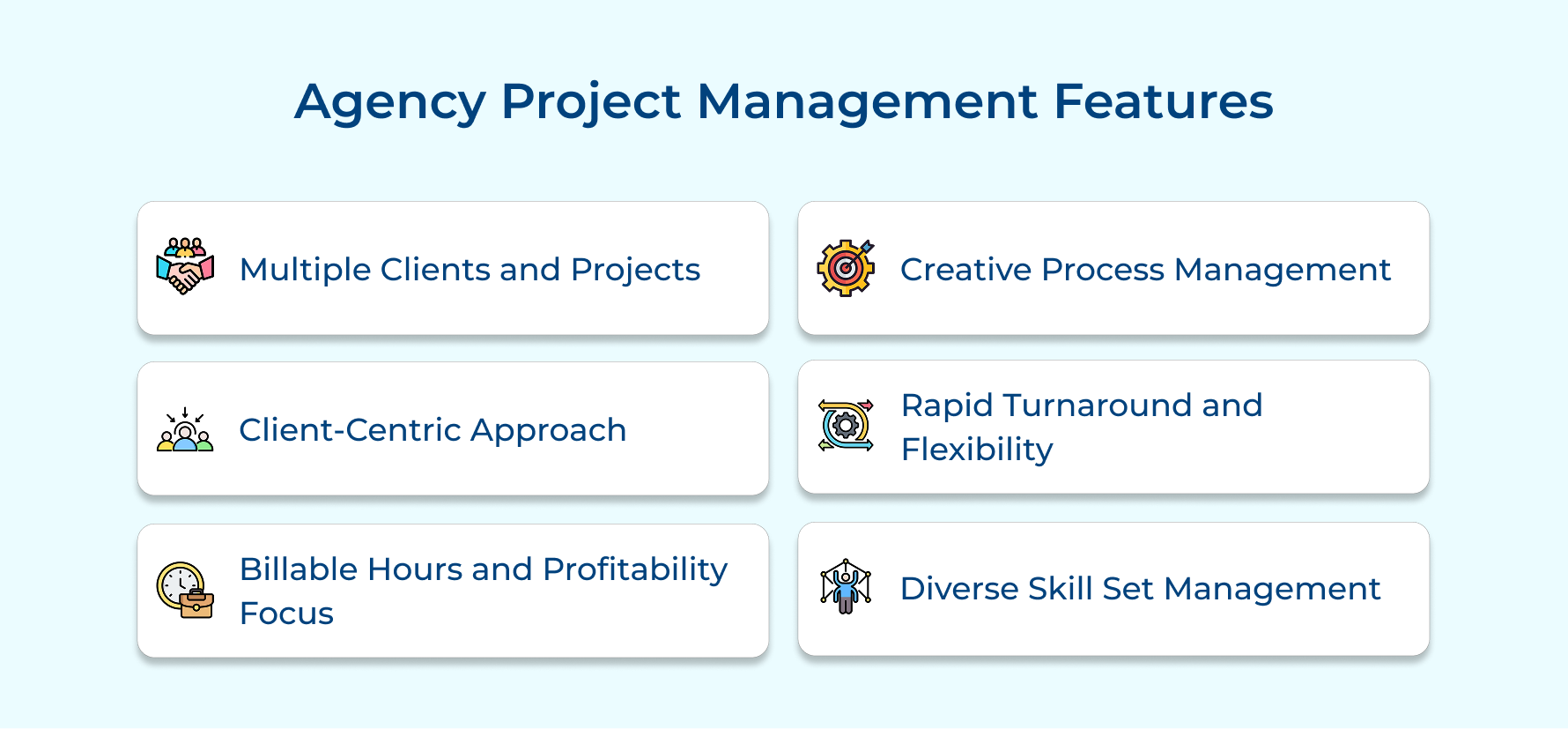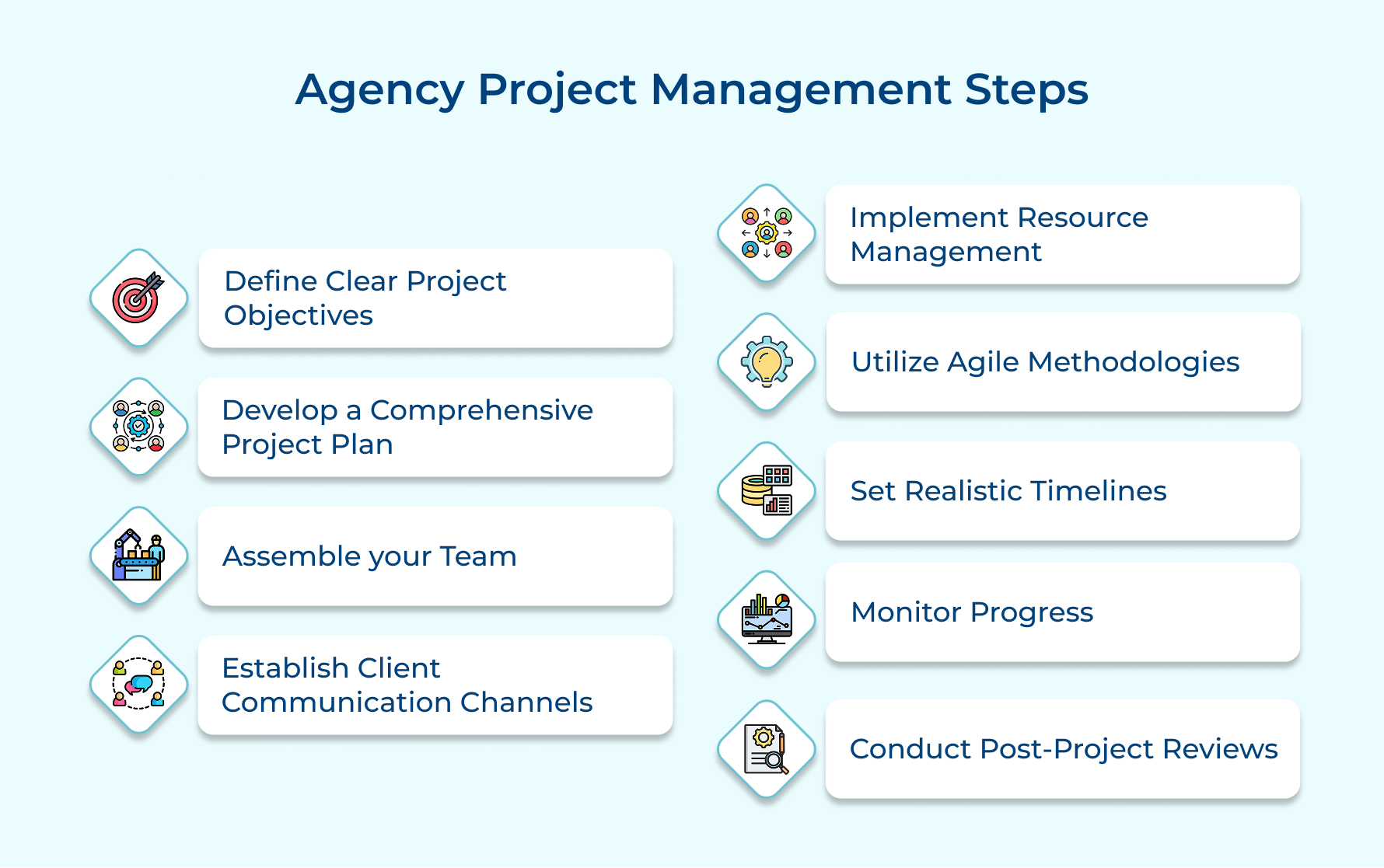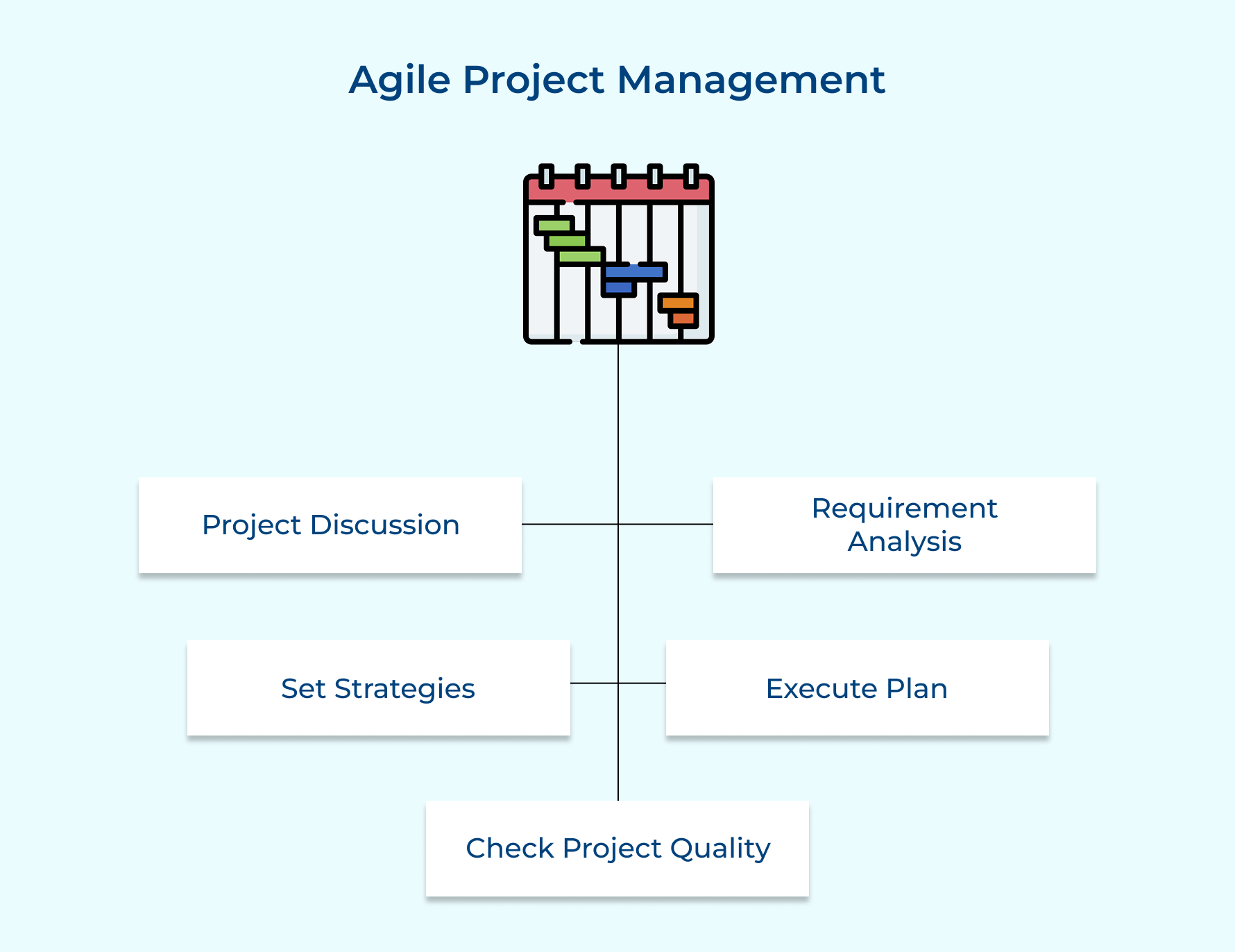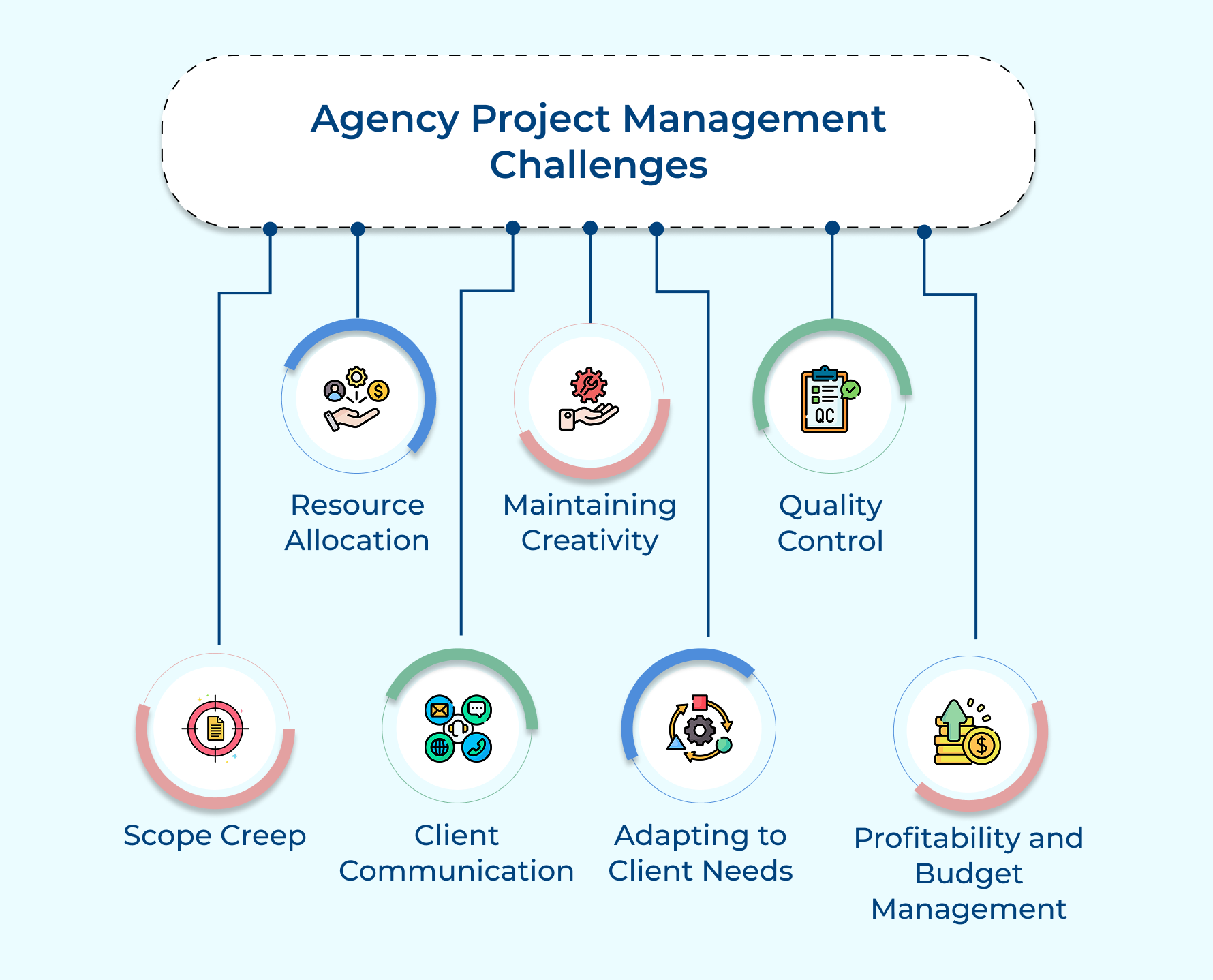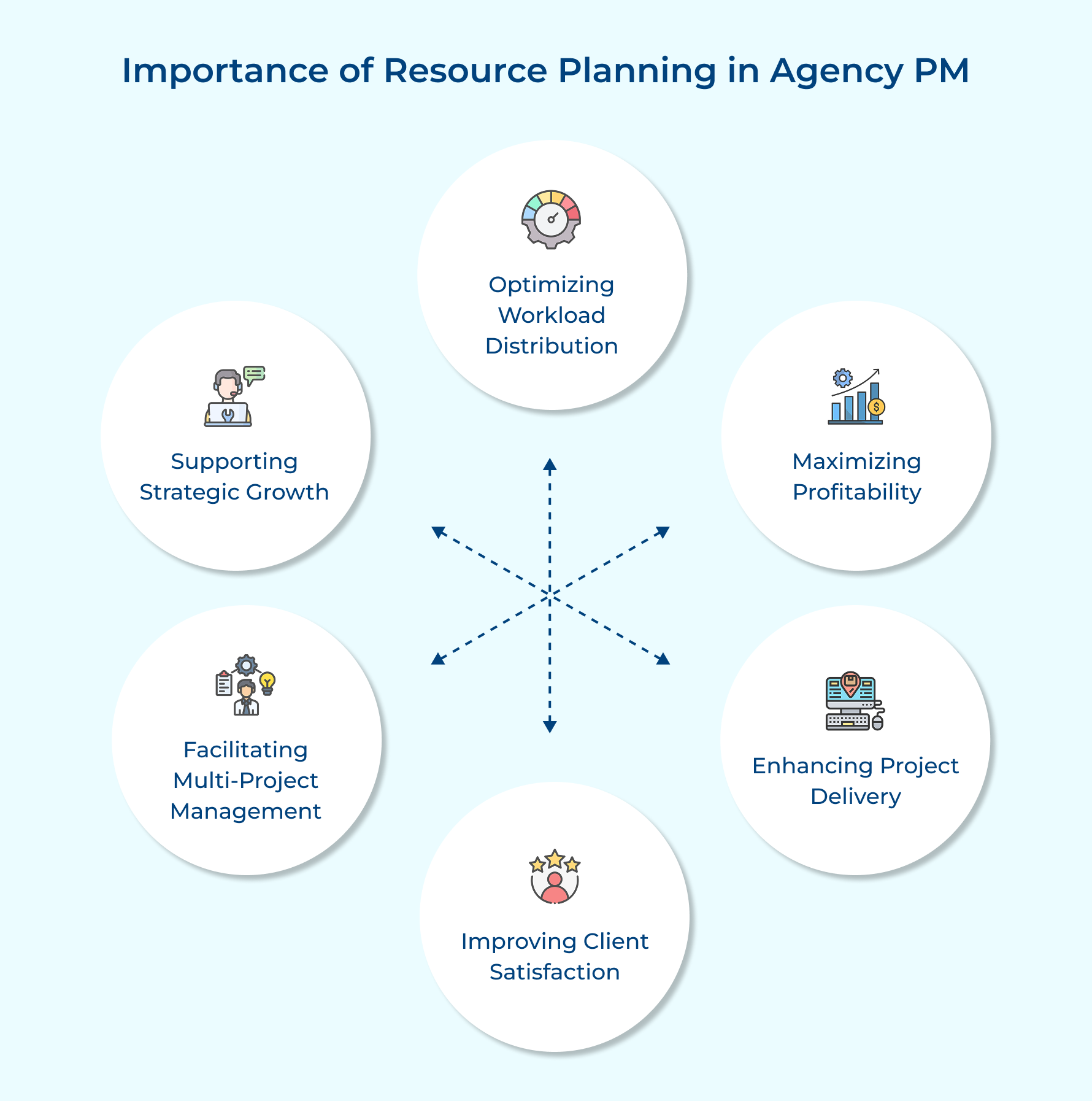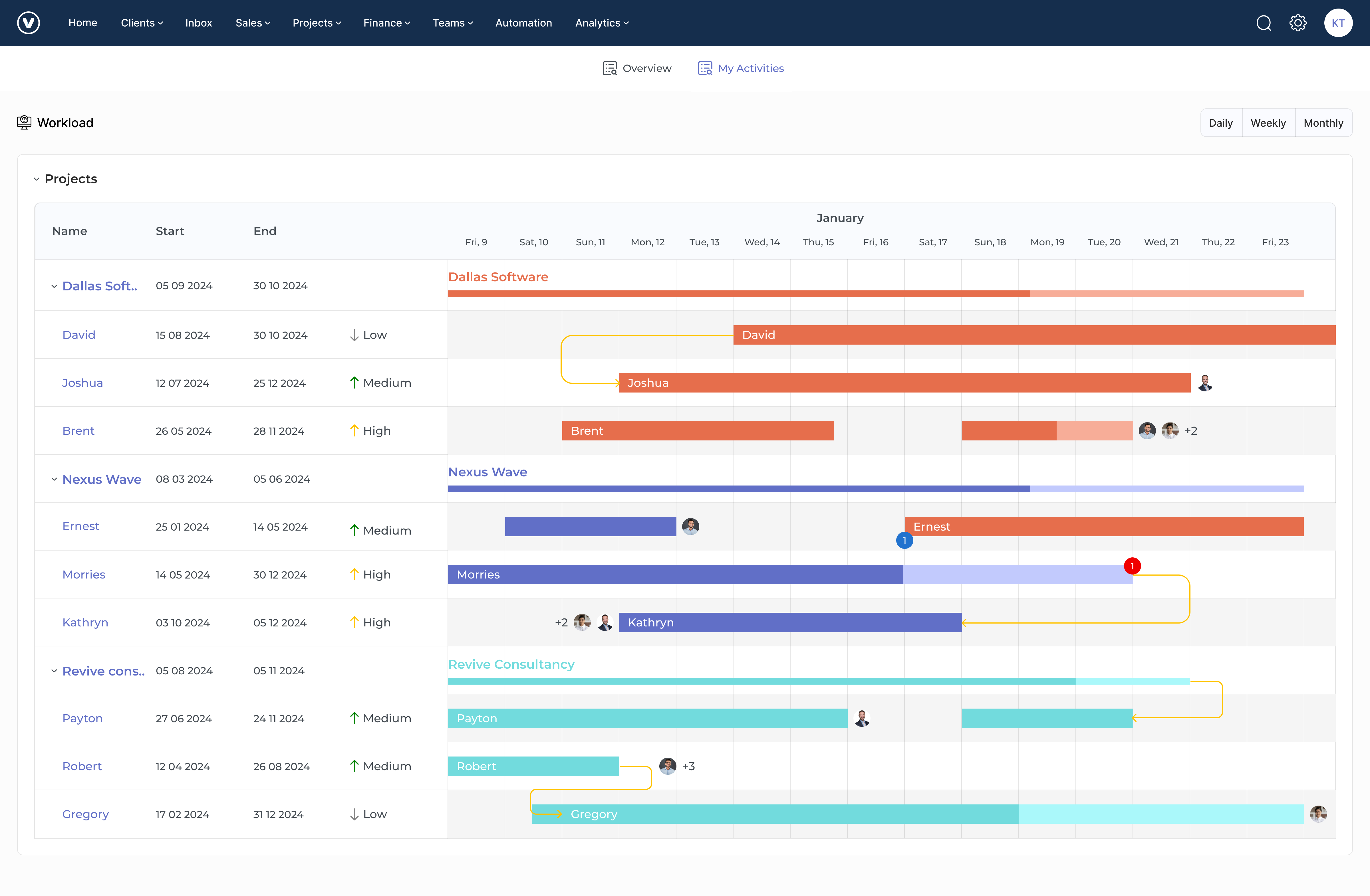Agency Project Management: The Definitive Guide
- What is Agency Project Management?
- Why is Agency Project Management Different from Others?
- 9 Steps to Master Agency Project Management
- Agency Project Management Challenges & Their Solutions
- Importance of Resource Planning in Agency Project Management
- Project Management Methods for Agencies
- Top Agency Project Management Tools
- Project Management by Agency Types
- Streamline Your Agency Project Management Delivery with Kooper
- FAQs about Agency Project Management

Key Highlights
Managing projects in agencies and professional services firms is a complex balancing act. With multiple clients, diverse project types, and constantly shifting priorities, project managers often find themselves overwhelmed by the task of maintaining control.
Agencies risk missing deadlines, exceeding budgets, and disappointing clients without a comprehensive project management approach. With the right strategies, organizations that use project management practices have a 92% success rate in meeting their objectives.
We’ll explore how agency project management is designed to transform your project management approach. It provides you with the strategies, tools, and insights needed to excel in the dynamic agency environment. Let’s jump right in!
What is Agency Project Management?
Agency Project Management is a specialized approach to managing projects within creative, marketing, or professional services agencies. It involves planning, executing, and overseeing projects for multiple clients simultaneously while balancing creative output with business objectives. This discipline encompasses coordinating various teams, managing client expectations, and allocating resources efficiently, all while ensuring the timely delivery of high-quality work within budget constraints.
Agency project management provides a structured approach to handling the unique challenges of agency work, such as managing multiple projects with varying timelines and priorities. Good project management practices contribute to an agency’s reputation for reliability and excellence, which is essential for attracting new clients as well as talent alike.
Key objectives:
- Client satisfaction: Deliver high-quality work that meets or exceeds client expectations builds long-term relationships and repeat business.
- Resource optimization: Efficiently allocate human and material resources across multiple projects to maximize productivity along with profitability.
- Timeline and budget adherence: Ensure projects are completed on time and within the agreed budget. It assures the agency’s credibility and financial health.
- Team empowerment: Create a collaborative environment that encourages creativity, problem-solving, and professional growth among team members.
Why is Agency Project Management Different from Others?
A creative agency project management ensures that its core value is customer-centric that is profitable and just as flexible. Let’s look into the other factors determining its distinction.
1. Manage Multiple Clients and Projects Simultaneously
Unlike many other industries where project managers might focus on one or a few large projects at a time, agency project managers often juggle multiple clients and projects simultaneously. It requires exceptional organizational skills, the ability to switch contexts quickly, and a keen sense of prioritization. Agency project managers must be adept at balancing resources across various projects, each with its own timeline, budget, and client expectations.
2. Creative Process Management
Agencies, particularly in marketing, advertising, and design fields, deal heavily with creative processes. Managing creative work requires a different approach than managing more linear, predictable projects. Agency project managers need to allow space for creativity and ideation while still maintaining project structure as well as timelines. They must be skilled at facilitating brainstorming sessions, managing creative feedback, and translating creative ideas into actionable project tasks.
3. Client-centric Approach
While all project management involves stakeholder management, agency work is particularly client-centric. Client satisfaction is paramount, and project managers often need to act as a bridge between the client as well as the internal team. It generally involves managing client expectations, often educating clients on processes, and sometimes pushing back on client requests to maintain project integrity. The ability to build and maintain strong client relationships is crucial in agency project management.
4. Rapid Turnaround and Flexibility
Agency projects often operate on much shorter timelines than projects in other industries. Clients may need deliverables in days or weeks rather than months or years. The fast-paced environment requires agency project managers to be highly adaptable and quick-thinking. They need to be comfortable with change and able to pivot strategies rapidly in response to client feedback or market changes.
5. Billable Hours and Profitability Focus
In many agencies, there’s a strong focus on billable hours and project profitability. Agency project managers need to be acutely aware of how time is being spent and how it affects the bottom line. They often need to balance delivering high-quality work with maintaining profit margins, which can involve difficult decisions about resource allocation and scope management.
6. Diverse Skill Set Management
Agency teams often consist of professionals with diverse skill sets – from designers, copywriters to developers and strategists. Project managers in this environment need to understand the capabilities and limitations of various roles, and effectively coordinate cross-functional teams while ensuring smooth collaboration between departments. They also need to be adept at resource allocation, ensuring that the right skills are available at the right time for each project.
9 Steps to Master Agency Project Management
Regardless of whether it is marketing agency project management, advertising, or designing, following the right strategy fetches better overall success. Here’s the list of steps to consider:
1. Define Clear Project Objectives and Scope
Defining clear project objectives is crucial in agency project management because it sets the foundation for the entire project. It ensures that all stakeholders, including the client and internal teams, have a shared understanding of what needs to be achieved.
Start by collaborating with the client to identify their goals and expectations. Translate these into specific objectives for the project. Clearly outline what is included in the project scope and, equally important, what is not. Use this information to create a project brief that serves as a reference point throughout the project lifecycle.
Best practices:
- Use the SMART criteria (Specific, Measurable, Achievable, Relevant, Time-bound) when defining objectives to ensure clarity and accountability.
- Involve key stakeholders, including the client and internal team leads, in the scope definition process to gain buy-in as well as ensure all perspectives are considered.
- Document the project scope in detail, including deliverables, constraints, assumptions, etc., and have it signed off by the client to minimize misunderstandings later in the project.
2. Develop a Comprehensive Project Plan
A comprehensive project plan serves as a roadmap for the entire project. It outlines how the project will be executed, monitored, and controlled. A well-developed plan helps in coordinating efforts, and allocating resources effectively, while also managing client expectations throughout the project lifecycle.
Create a detailed project plan that includes tasks, timelines, milestones, resource requirements, and dependencies. Use this plan to guide daily activities, track progress, and make informed decisions. Regularly update the plan to reflect changes and keep it as a living document. Share it with team members as well as clients to ensure everyone is aligned on the project’s direction.
Best practices:
- Use a Work Breakdown Structure (WBS) to break down the project into manageable components.
- Incorporate buffer time into the schedule to account for unexpected delays or client feedback cycles, improving the plan’s resilience.
- Use project management software to create and maintain the plan, making it easier to update and share with stakeholders in real-time.
3. Assemble and Empower Your Dream Team
Assembling as well as empowering the right team is crucial in agency project management because the team’s skills, experience, and dynamics directly impact project outcomes. A well-composed team can overcome challenges, innovate solutions, and execute tasks efficiently. Empowering the team creates ownership, creativity, and motivation, leading to higher quality work as well as increased client satisfaction.
Start by identifying the skills and expertise required for the project. Look for team members who not only have the necessary technical skills but also possess soft skills like communication and adaptability. Assign roles and responsibilities based on individual strengths. Empower the team by delegating authority, encouraging decision-making, and providing the resources they need to succeed.
Best practices:
- Create cross-functional teams that blend different skill sets and perspectives to build innovation as well as comprehensive problem-solving.
- Implement a clear onboarding process for new team members to ensure they quickly understand their roles, the project objectives, and agency processes.
- Create a culture of trust and open communication within the team, encouraging members to share ideas, concerns, as well as feedback freely.
4. Establish Effective Client Communication Channels
Clear and timely communication is the foundation of successful client relationships. It ensures that clients are informed, aligned, and can provide timely feedback. Though poor communication leads to misunderstandings, effective channels help in managing expectations and maintaining client trust throughout the project.
Implement a variety of communication tools tailored to the client’s preferences and project needs. It might include regular status meetings, progress reports, collaborative platforms, and designated points of contact. Create a communication plan that outlines frequency, and format, along with recipients for various updates. Use these channels to share progress, seek approvals, while addressing any issues or changes promptly.
Best practices:
- Establish a single point of contact for the client to ensure consistent communication and avoid confusion or conflicting messages.
- Use a client-facing project management tool that allows clients to view progress, provide feedback, and access deliverables in real-time.
- Schedule regular check-ins with clients to proactively address concerns, showcase progress, and maintain engagement throughout the project lifecycle.
5. Implement Robust Resource Management
Optimal utilization of the agency’s most valuable assets are its people and tools. Effective resource management prevents overallocation, reduces burnout, and maximizes productivity. It helps in balancing workloads across multiple projects, meeting deadlines consistently, and maintaining high-quality output.
Implement resource management software to track the availability, skills, and workload of team members across all projects. Use this information to allocate resources efficiently, identify potential conflicts, and plan for future needs. Regularly review resource utilization and capacity to prevent overallocation. Consider cross-training team members to increase flexibility in resource allocation.
Best practices:
- Conduct regular capacity planning sessions to forecast resource needs and identify potential shortfalls or excesses in advance.
- Implement a skills matrix to match team members with appropriate tasks, ensuring efficient use of expertise and promoting professional development.
- Use time-tracking tools to monitor actual time spent on tasks, providing data for more accurate future estimates and resource allocation.
6. Utilize Agile Project Management Methodologies
Agile approaches allow for flexibility, faster response to changes, and continuous improvement. They promote collaboration, transparency, and client involvement throughout the project lifecycle. Adaptability is crucial for managing evolving client needs, market changes, and the creative process inherent in agency work.
Implement Agile practices such as Scrum or Kanban in your project management approach. Break projects into smaller, manageable sprints with regular deliverables. Involve clients in regular reviews to gather feedback early and often, allowing for course corrections while ensuring alignment with client expectations.
Best practices:
- Start with a hybrid approach, blending Agile methodologies with traditional project management techniques to ease the transition and accommodate different project types.
- Use visual management tools like Kanban boards to increase transparency and help team members as well as clients understand project progress at a glance.
- Create an Agile mindset within the team, emphasizing adaptability, continuous learning, and client-centricity in all aspects of project execution.
7. Set Realistic Timelines and Milestones
Setting realistic timelines provides a clear roadmap for progress and helps manage client expectations. Unrealistic timelines can lead to rushed work, compromised quality, and team burnout. Well-defined milestones serve as checkpoints to assess progress, celebrate achievements, and make necessary adjustments.
Begin by breaking down the project into manageable phases and tasks. Estimate the time required for each task, considering team capacity, potential obstacles, and client feedback cycles. Use these timelines as well as milestones to create a project schedule, allocate resources, and set expectations with clients.
Best practices:
- Involve team members in the estimation process to leverage their expertise and increase buy-in for the established timelines.
- Use historical data from similar projects to inform time estimates and improve accuracy, accounting for agency-specific factors as well as client tendencies.
- Build buffer time for unexpected client requests, revisions, or internal bottlenecks, especially for critical path activities.
8. Monitor Progress and Adapt to Changes
Regular monitoring helps identify issues early, allowing for timely interventions. The ability to adapt to changes is crucial for managing evolving client needs, market shifts, or unexpected challenges. This flexibility ensures that projects remain aligned with client objectives and deliver value despite changing circumstances.
Implement a system for regular progress updates, such as daily stand-ups or weekly status reports. Compare actual progress against the planned schedule and budget. Analyze variances to identify potential issues or areas needing attention. Be prepared to adjust strategies, reallocate resources, or revise timelines in response to changes or new information.
Best practices:
- Establish clear metrics and key performance indicators (KPIs) to measure progress objectively as well as consistently throughout the project.
- Implement a formal change management process to evaluate and incorporate client requests or necessary adjustments while maintaining project integrity.
- Build a culture of transparency and open communication, encouraging team members to report challenges or propose solutions proactively.
9. Conduct Post-Project Reviews for Continuous Improvement
The post-project reviews provide an opportunity to reflect on successes, challenges, and lessons learned. These reviews contribute to refining processes, and improving client satisfaction, all while developing best practices that can be applied to future projects.
Schedule a post-project review meeting soon after project completion. Involve all team members and key stakeholders. Discuss what went well, what could be improved, and any unexpected challenges faced. Use this information to update project management processes, templates, and best practices. Share key learnings across the agency to benefit other projects and teams.
Best practices:
- Create a safe, blame-free environment for the review to encourage honest and constructive feedback from all participants.
- Use a structured format for the review, such as the “Start, Stop, Continue” method, to ensure comprehensive coverage of all aspects of the project.
- Develop an action plan based on the review findings to ensure that lessons learned are actually implemented in future projects and agency processes.
Agency Project Management Challenges & Their Solutions
Managing projects in an agency setting comes with unique challenges – from shifting client demands to tight deadlines. Here’s a look at common hurdles and how to overcome them.
1. Scope Creep
Challenge: Scope creep occurs when project requirements gradually expand beyond the original agreement, often without corresponding adjustments to timelines or budgets. This is particularly common in agency settings where clients may continually request “small” additions or changes.
Solution: Establish a clear, detailed scope of work at the project’s outset and get client sign-off. Implement a formal change request process for any additions or modifications. Each change should be documented, evaluated for its impact on the timeline as well as budget, and approved by both the agency along the client before implementation. Regular scope reviews with the client can help manage expectations and prevent gradual, unnoticed expansions.
2. Resource Allocation across Multiple Projects
Challenge: Agencies often juggle multiple projects simultaneously, making it difficult to allocate resources effectively. It leads to overworked team members, bottlenecks, and project delays.
Solution: Implement robust resource management software to track team capacity and project demands. Use this data to balance workloads and identify potential conflicts early. Consider cross-training team members to increase flexibility. Establish clear processes for prioritizing projects and resolving resource conflicts. Regular capacity planning sessions can help anticipate and address resource needs proactively.
3. Client Communication and Expectation Management
Challenge: Maintaining clear, consistent communication with clients and managing their expectations throughout the project can be challenging – especially when dealing with multiple stakeholders or complex projects.
Solution: Establish a communication plan at the project’s outset, detailing frequency, methods, and points of contact. Use project management software that allows clients to view progress in real-time. Schedule regular check-ins to provide updates and gather feedback. Be transparent about challenges and proactive in proposing solutions. Educate clients about the agency’s processes and the rationale behind decisions to build trust.
4. Maintaining Creativity within Project Constraints
Challenge: Balancing the need for creativity and innovation with project constraints like timelines as well as budgets can be difficult, potentially leading to uninspired work or missed deadlines.
Solution: Create a culture that values both creativity and efficiency. Use techniques like time-boxing for creative tasks to ensure focus. Implement collaborative ideation sessions early in the project to generate innovative ideas within the project’s constraints. Encourage ongoing professional development to help team members work more creatively and efficiently.
5. Adapting to Changing Client Needs
Challenge: Client priorities or market conditions can shift during a project, requiring agencies to adapt quickly while maintaining project integrity and profitability.
Solution: Adopt Agile project management methodologies to increase flexibility. Break projects into smaller phases or sprints, allowing for regular reassessment and course correction. Maintain open lines of communication with clients to stay aware of potential changes. Build some flexibility into project plans and contracts to accommodate reasonable adjustments without derailing the entire project.
6. Quality Control across Multiple Deliverables
Challenge: Ensuring consistent quality across all project deliverables can be challenging, especially when working under tight deadlines or with multiple team members.
Solution: Implement a robust quality assurance process with clear standards and checkpoints throughout the project lifecycle. Use peer reviews and senior staff oversight for critical deliverables. Maintain a library of best practices and templates to ensure consistency. Invest in training to elevate the skills of all team members. Use project management software to track revisions and approvals, ensuring nothing slips through the cracks.
7. Profitability and Budget Management
Challenge: Maintaining profitability while delivering high-quality work can be difficult, especially when dealing with fixed-price contracts or unexpected project complications.
Solution: Improve estimation accuracy by analyzing historical project data. Use time-tracking tools to understand where hours are being spent and identify inefficiencies. Implement regular budget reviews to catch overruns early. Be transparent with clients about budget constraints and work collaboratively to find solutions that maintain project quality.
Importance of Resource Planning in Agency Project Management
Effective resource planning is crucial for timely, high-quality project delivery in agencies. Let’s explore its other relevant factors, showcasing the importance of resource planning:
- Optimizing Workload Distribution
Effective resource planning ensures that work is distributed evenly across team members, preventing burnout and maintaining high-quality output. It allows project managers to identify potential overallocation or underutilization of staff early, enabling them to make necessary adjustments. This balanced approach not only improves project outcomes but also contributes to employee satisfaction and retention.
- Maximizing Profitability
Accurate resource allocation maximizes billable hours and project profitability. Resource planning helps in identifying the most cost-effective way to staff projects, balancing the need for specialized skills within a set budget. It also aids in forecasting resource needs, allowing agencies to make informed decisions about hiring or training. Thus, optimizing their workforce for long-term profitability.
- Enhancing Project Delivery
Proper resource planning ensures that the right people with the right skills are available at the right time. The alignment significantly improves project delivery, reducing delays and ensuring that critical tasks are completed by the most qualified team members. It also allows for better sequencing of tasks, minimizing bottlenecks and improving overall project flow.
- Improving Client Satisfaction
When resources are well-planned, agencies can provide more accurate timelines and deliverables to clients. This reliability enhances client trust and satisfaction. Effective resource planning allows agencies to quickly respond to client requests, as they have a clear view of available resources and can reallocate as needed without disrupting other projects.
- Facilitating Multi-project Management
In an agency setting where multiple projects run concurrently, resource planning is crucial for maintaining a bird’s-eye view of all ongoing work. It helps in identifying conflicts between projects, allowing for proactive resolution. The overview also aids in prioritizing projects and making strategic decisions about which projects to take on based on resource availability.
- Supporting Strategic Growth
Resource planning provides helpful insights for strategic decision-making regarding business growth. It helps agency leaders identify skill gaps, make informed decisions about expanding service offerings, and plan for scaling the business. By understanding resource utilization patterns, agencies can also identify opportunities for efficiency improvements and innovation.
Project Management Methods for Agencies
The choice of project management style often depends on the agency’s size, client base, and type of work. The key is to choose a combination of styles that enhances the agency’s growth.
1. Agile Project Management
Increasingly popular in agencies, Agile methodologies like Scrum or Kanban offer flexibility and adaptability. This style involves breaking projects into smaller sprints, allowing for frequent client feedback and easy adjustments. It’s particularly useful for creative projects where requirements may evolve. Agile promotes collaboration, transparency, and continuous improvement, aligning well with the iterative nature of agency work.
2. Waterfall Approach
While less common in modern agencies, the Waterfall method is still used for projects with clear, unchanging requirements. It follows a linear, sequential approach, moving from one phase to the next only when the previous is complete. It can be effective for large-scale, long-term projects with well-defined scopes, but lacks flexibility for typical agency work.
3. Hybrid Approaches
Many agencies adopt a hybrid style, blending elements of Agile and traditional methods. It allows for flexibility in creative processes while maintaining structure for planning and delivery. Hybrid approaches can be tailored to specific client needs or project types, offering a balance between adaptability and predictability.
4. Lean Project Management
Focused on maximizing value while minimizing waste, Lean principles are gaining traction in agencies. This style emphasizes efficiency, continuous improvement, and delivering only what the client values. It’s particularly useful for agencies looking to streamline processes and improve profitability.
Top Agency Project Management Tools
Agency project management streamlines every workflow in the services sector. Here are the key tools that aren’t just AI-powered but supercharge your workflow efficiency like never before!
1. Kooper
Best agency project management software for resource planning tools
Kooper is an all-in-one agency project management software designed to streamline operations for professional service businesses. It combines project management, time tracking, resource planning, sales CRM, and financial management into a single platform. Kooper aims to help agencies increase profitability by providing real-time insights into project performance, resource utilization, and financial health.
Key features:
- Project management: Kooper offers comprehensive project management capabilities, including task lists, Kanban boards, and Gantt charts. It allows for the easy creation of project templates, and setting milestones while tracking progress. It also provides a high-level overview of all agency projects, helping managers identify potential issues early.
- Resource planning: The resource planning feature in Kooper allows managers to allocate team members to projects based on their skills as well as availability. It provides a visual representation of resource utilization, helping to prevent overbooking and ensure optimal workload distribution. The tool also offers capacity planning to help agencies make informed decisions about hiring along with project commitments.
- Time tracking and approval: The tool includes an integrated time tracking system that allows team members to log time against specific tasks or projects. It offers features like automatic time-tracking suggestions based on calendar events and the ability to set up approval workflows for timesheets.
- Financial management: The financial management module in Kooper covers budgeting, expense tracking, invoicing, etc. It allows agencies to set project budgets, and track actual costs against estimates while generating invoices based on tracked time or fixed project fees. The tool also provides profitability reports at the project, client, and agency levels.
- Client management: Kooper offers features for managing client relationships, including a client portal for sharing project updates. It allows agencies to track client communications, store important documents, and manage client-specific rates as well as billing preferences.
- Lead management: Kooper offers a robust lead management system, allowing agencies to track and nurture potential clients. It includes features for capturing leads from various sources as well as assigning them to team members while tracking the progress of each lead through the sales pipeline. The tool also provides email templates and scheduling features to streamline follow-ups.
- Reporting and analytics: The tool provides a wide range of reports and dashboards covering all aspects of agency operations. Users can generate reports on project profitability, resource utilization, team performance, and overall agency health. These insights help agencies make data-driven decisions to improve efficiency.
2. ClickUp
ClickUp is a versatile project management and productivity platform that caters to various industries, including agencies. It offers a highly customizable interface and a wide range of features to manage tasks, projects, team collaboration, etc. ClickUp enables agencies to tailor the tool to their specific workflows, making it adaptable to different project management styles and client needs.
Key Features:
- Customizable views including List, Board, Calendar, and Gantt charts.
- Time tracking as well as reporting capabilities.
- Workflow automation and AI-assisted task management.
- Extensive integration options with other tools and platforms.
3. Jira
Jira, developed by Atlassian, is a powerful project management tool originally designed for software development but is now widely used across various industries, including agencies. It offers robust features for task tracking, process management, and reporting. Jira’s strength lies in its flexibility to adapt to different project management methodologies and its extensive customization options.
Key Features:
- Customizable workflows and Kanban boards.
- Agile reporting along with burndown charts.
- Roadmaps for strategic planning and tracking.
- Powerful search and filtering capabilities.
4. Asana
Asana is a versatile project management and team collaboration tool widely used by agencies. It offers a user-friendly interface as well as a range of features to manage tasks, projects, and workflows. Asana’s strength lies in allowing agencies to organize and track work in a way that best suits their processes, from simple task lists to complex project pipelines.
Key Features:
- Multiple project views including List, Board, Timeline, and Calendar.
- Workflow automation and task dependencies.
- Team workload management as well as resource allocation.
- Customizable templates and integrations with popular tools.
Project Management by Agency Types
The key to successful project management in either type of agency lies in understanding the unique challenges and requirements. Let’s learn the extensive list of agency types.
1. Marketing Agencies
Marketing agencies often deal with diverse projects ranging from content creation to digital campaigns. Project management in these agencies focuses on balancing creativity with data-driven strategies. They typically use Agile methodologies to adapt quickly to market trends and client feedback. Key challenges include managing multiple channels, coordinating with external vendors, and measuring campaign effectiveness. Tools that integrate analytics and project management are crucial.
2. Advertising & PR Agencies
Agencies that manage ads and PR often work on time-sensitive, high-stakes projects that require significant creative input. Project management here involves managing tight deadlines, coordinating large creative teams, and handling last-minute changes from clients. They often use a mix of Waterfall for overall campaign structure and Agile for execution. Stakeholder management is critical, as projects often involve multiple client touchpoints.
3. Design Agencies
Design agencies focus heavily on the creative process, requiring project management approaches that allow for iteration and client feedback. They often use design-specific project management tools that integrate with design software. Sprints and regular client check-ins are common to ensure alignment with the client’s vision. Resource management is crucial, as projects can be resource-intensive and timelines can be fluid.
4. Web Development Agencies
These agencies typically adhere more strictly to Agile methodologies like Scrum or Kanban. Project management focuses on sprint planning, daily stand-ups, and regular iterations. They often use technical project management tools that integrate with development environments. Key challenges include managing scope creep, technical debt, and ensuring clear communication between technical teams as well as clients.
5. In-house Agencies
The agencies here face unique challenges in project management as they balance internal stakeholders’ needs with resource constraints. In-house often need to prioritize projects across different departments and align with overall company strategies. Project management here focuses on resource allocation, cross-departmental collaboration, and demonstrating value to the organization.
6. Professional Services Agencies
Agencies which include consulting firms, law firms, and accounting firms, often deal with long-term, complex projects. Project management in these settings focuses on managing billable hours, ensuring compliance with industry regulations, and maintaining long-term client relationships. They often use traditional project management methodologies with a strong emphasis on documentation and client communication.
Despite these differences, all types of agencies share some common project management needs:
- Resource management: Effectively allocate and balance resources across multiple projects.
- Client communication: Regular and clear communication with clients is crucial in both settings.
- Budget management: Keeping projects profitable while delivering high-quality work is a priority for both.
- Adaptability: Responsive to changing client needs and market conditions.
Streamline Your Agency Project Management Delivery with Kooper
Agencies must understand the project management lifecycle to maintain profitability and client retention. Effective management of each stage, from initiation to closure, ensures efficient resource allocation, timely deliverables, and client satisfaction.
An integrated agency management platform like Kooper can streamline this process by providing a unified system for project tracking, resource management, and client communication. Kooper enables agencies to optimize their operations, improve project outcomes, and enhance client experiences by centralizing data as well as automating workflows. Effective project management leads to improved resource utilization, client satisfaction, and overall agency success.
Limit time — not creativity
Everything you need for customer support, marketing & sales.
Neeti Singh is a passionate content writer at Kooper, where he transforms complex concepts into clear, engaging and actionable content. With a keen eye for detail and a love for technology, Tushar Joshi crafts blog posts, guides and articles that help readers navigate the fast-evolving world of software solutions.
